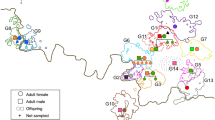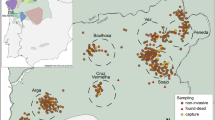Abstract
Dispersal has a significant impact on lifetime reproductive success1, and is often more prevalent in one sex than the other2. In group-living mammals, dispersal is normally male-biased and in theory this sexual bias could be a response by males to female mate preferences, competition for access to females or resources, or the result of males avoiding inbreeding2,3,4,5,6,7. There is a lack of studies on social mammals that simultaneously assess these factors and measure the fitness consequences of male dispersal decisions. Here we show that male-biased dispersal in the spotted hyaena (Crocuta crocuta) most probably results from an adaptive response by males to simple female mate-choice rules that have evolved to avoid inbreeding. Microsatellite profiling revealed that females preferred sires that were born into or immigrated into the female’s group after the female was born. Furthermore, young females preferred short-tenured sires and older females preferred longer-tenured sires. Males responded to these female mate preferences by initiating their reproductive careers in groups containing the highest number of young females. As a consequence, 11% of males started their reproductive career in their natal group and 89% of males dispersed. Males that started reproduction in groups containing the highest number of young females had a higher long-term reproductive success than males that did not. The female mate-choice rules ensured that females effectively avoided inbreeding without the need to discriminate directly against close kin or males born in their own group, or to favour immigrant males. The extent of male dispersal as a response to such female mate preferences depends on the demographic structure of breeding groups, rather than the genetic relatedness between females and males.
This is a preview of subscription content, access via your institution
Access options
Subscribe to this journal
Receive 51 print issues and online access
$199.00 per year
only $3.90 per issue
Buy this article
- Purchase on Springer Link
- Instant access to full article PDF
Prices may be subject to local taxes which are calculated during checkout




Similar content being viewed by others
References
Alberts, S. C. & Altmann, J. Balancing costs and opportunities: dispersal in male baboons. Am. Nat. 145, 279–306 (1995)
Greenwood, P. J. Mating systems, philopatry and dispersal in birds and mammals. Anim. Behav. 28, 1140–1162 (1980)
Lehmann, L. & Perrin, N. Inbreeding avoidance through kin recognition: choosy females boost male dispersal. Am. Nat. 162, 638–652 (2003)
Dobson, F. S. Competition for mates and predominant juvenile male dispersal in mammals. Anim. Behav. 30, 1183–1192 (1982)
Moore, J. & Ali, R. Are dispersal and inbreeding avoidance related? Anim. Behav. 32, 94–112 (1984)
Cockburn, A., Scott, M. P. & Scotts, D. J. Inbreeding avoidance and male-biased natal dispersal in Antechinus spp. (Marsupialia: Dasyuridae). Anim. Behav. 33, 908–915 (1985)
Johnson, M. L. & Gaines, M. S. Evolution of dispersal: theoretical models and empirical tests using birds and mammals. Annu. Rev. Ecol. Syst. 21, 449–480 (1990)
Smith, R. H. On selection for inbreeding in polygynous animals. Heredity 43, 205–211 (1979)
Parker, G. A. in Mate Choice (ed. Bateson, P. P. G.) 141–166 (Cambridge Univ. Press, Cambridge, 1983)
Parker, G. A. in Sexual Selection and Reproductive Competition in Insects (eds Blum, M. S. & Blum, N. A.) 123–166 (Academic Press, New York, 1979)
Pusey, A. E. & Packer, C. in Primate Societies (eds Smuts, B. B., Cheney, D. L., Seyfarth, R. M., Wrangham, R. W. & Struhsaker, T. T.) 250–266 (Univ. Chicago Press, Chicago, 1986)
Keane, B. Dispersal and inbreeding avoidance in the white-footed mouse, Peromyscus leucopus. Anim. Behav. 40, 143–152 (1990)
Kruuk, H. The Spotted Hyena. A Study of Predation and Social Behavior (Univ. Chicago Press, Chicago, 1972)
East, M. L. & Hofer, H. Male spotted hyenas (Crocuta crocuta) queue for status in social groups dominated by females. Behav. Ecol. 12, 558–568 (2001)
Höner, O. P., Wachter, B., East, M. L., Runyoro, V. A. & Hofer, H. The effect of prey abundance and foraging tactics on the population dynamics of a social, territorial carnivore, the spotted hyena. Oikos 108, 544–554 (2005)
Matthews, L. H. Reproduction in the spotted hyaena, Crocuta crocuta, (Erxleben). Phil. Trans. R. Soc. Lond. B 230, 1–78 (1939)
East, M. L., Hofer, H. & Wickler, W. The erect 'penis' is a flag of submission in a female-dominated society: greetings in Serengeti spotted hyaenas. Behav. Ecol. Sociobiol. 33, 355–370 (1993)
East, M. L., Burke, T., Wilhelm, K., Greig, C. & Hofer, H. Sexual conflicts in spotted hyenas: male and female mating tactics and their reproductive outcome with respect to age, social status and tenure. Proc. R. Soc. Lond. B 270, 1247–1254 (2003)
Engh, A. L. et al. Reproductive skew among males in a female-dominated mammalian society. Behav. Ecol. 13, 193–200 (2002)
Hofer, H. & East, M. L. in Serengeti II. Dynamics, Management, and Conservation of an Ecosystem (eds Sinclair, A. R. E. & Arcese, P.) 332–363 (Elsevier, Chicago, 1995)
Trivers, R. L. in Sexual Selection and the Descent of Man (ed. Campbell, B.) 136–179 (Aldine, Chicago, 1972)
Smale, L., Nunes, S. & Holekamp, K. E. in Advances in the Study of Behavior Vol. 26 (eds Slater, P. J. B., Rosenblatt, J. S., Milinski, M. & Snowdon, C. T.) 181–250 (Academic Press, London, 1997)
Kokko, H. & Sutherland, W. J. Optimal floating and queuing strategies: consequences for density dependence and habitat loss. Am. Nat. 152, 345–366 (1998)
Sherman, P. W., Reeve, H. K. & Pfennig, D. W. in Behavioural Ecology—An Evolutionary Approach (eds Krebs, J. R. & Davies, N. B.) 69–96 (Blackwell Science, Oxford, 1997)
East, M. L. & Hofer, H. Loud calling in a female-dominated mammalian society: II. Behavioural contexts and functions of whooping of spotted hyaenas, Crocuta crocuta. Anim. Behav. 42, 651–669 (1991)
Manly, B. F. J., McDonald, L. L. & Thomas, D. L. Resource Selection by Animals. Statistical Design and Analysis for Field Studies (Chapman & Hall, London, 1993)
Albert, R. Genstruktur und Genfluß in ausgewählten Populationen der Tüpfelhyäne (Crocuta crocuta). PhD thesis, Freie Universität Berlin. (2002)
McFadden, D. in Frontiers in Econometrics (ed. Zarembka, P.) 105–142 (Academic Press, New York, 1974)
Wilhelm, K. et al. Characterization of spotted hyena, Crocuta crocuta, microsatellite loci. Mol. Ecol. Notes 3, 360–362 (2003)
Marshall, T. C., Slate, J., Kruuk, L. E. B. & Pemberton, J. M. Statistical confidence for likelihood-based paternity inference in natural populations. Mol. Ecol. 7, 639–655 (1998)
Acknowledgements
We thank the Tanzania Commission for Science and Technology for permission to conduct the study, the Tanzania Wildlife Research Institute, the Ngorongoro Conservation Area Authority, A. Francis, L. Kimaay, T. Ndooto, G. Orio, H. Richner, D. Thierer, C. Trout, L. Trout, C. Voigt and W. Wickler for their assistance and suggestions. This study was financed by the Leibniz Institute for Zoo and Wildlife Research, the Fritz-Thyssen-Stiftung, the Stifterverband der deutschen Wissenschaft, the Max Planck Society, the German Academic Exchange Service (DAAD) and the Messerli Foundation.
Author information
Authors and Affiliations
Corresponding author
Ethics declarations
Competing interests
Reprints and permissions information is available at www.nature.com/reprints. The authors declare no competing financial interests.
Rights and permissions
About this article
Cite this article
Höner, O., Wachter, B., East, M. et al. Female mate-choice drives the evolution of male-biased dispersal in a social mammal. Nature 448, 798–801 (2007). https://doi.org/10.1038/nature06040
Received:
Accepted:
Published:
Issue Date:
DOI: https://doi.org/10.1038/nature06040
This article is cited by
-
Pre-migratory flights in migrant songbirds: the ecological and evolutionary importance of understudied exploratory movements
Movement Ecology (2023)
-
Community structure of the solitary giant pandas is maintained by indirect social connections
Movement Ecology (2022)
-
The expanding value of long-term studies of individuals in the wild
Nature Ecology & Evolution (2022)
-
Maladaptive evolution or how a beneficial mutation may get lost due to nepotism
Communications Biology (2022)
-
The value of individual identification in studies of free-living hyenas and aardwolves
Mammalian Biology (2022)
Comments
By submitting a comment you agree to abide by our Terms and Community Guidelines. If you find something abusive or that does not comply with our terms or guidelines please flag it as inappropriate.



